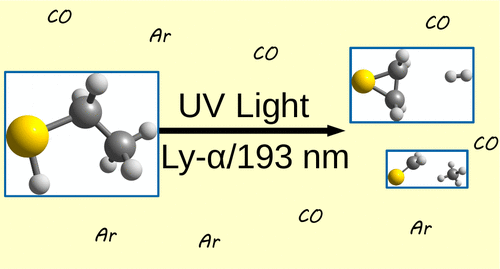当前位置:
X-MOL 学术
›
ACS Earth Space Chem.
›
论文详情
Our official English website, www.x-mol.net, welcomes your
feedback! (Note: you will need to create a separate account there.)
UV Photolysis of C2H5SH in Solid CO and Ar
ACS Earth and Space Chemistry ( IF 2.9 ) Pub Date : 2021-12-15 , DOI: 10.1021/acsearthspacechem.1c00310
Joanna Purzycka 1 , Thomas Custer 1 , Marcin Gronowski 1
ACS Earth and Space Chemistry ( IF 2.9 ) Pub Date : 2021-12-15 , DOI: 10.1021/acsearthspacechem.1c00310
Joanna Purzycka 1 , Thomas Custer 1 , Marcin Gronowski 1
Affiliation

|
Ethanethiol (C2H5SH) contains the −SH group, a functional group considered to be crucial for the prebiotic polymerization of amino acids. Ethanethiol is also one of about 250 molecules detected in the interstellar medium or circumstellar shells. We irradiated C2H5SH embedded in carbon monoxide (CO) as well as argon (Ar) ices. Using spectroscopy, we detected methane (CH4), ethane (C2H6), ethylene (C2H4), acetylene (C2H2), carbon monosulfide (CS), carbonyl sulfide (OCS), dihydrogen sulfide (SH2), thioformaldehyde (H2CS), ethanethial (CH3CHS), thiirane, ethenethione (H2CCS), ethynethiol (HCCSH), thiirene, ethenedithione (SCCS), methylene radical (CH2), ethylthiyl radical (C2H5S), thioketenyl radical (HCCS), sulfanyl radical (SH), and sulfur atoms. Additionally, we observed OCS luminescence during annealing of the Ar matrix sample, which indicates the existence of a free sulfur atom. All products contain fewer atoms than the parent. CH3CHS was the main organic product in CO; OCS is the only product detected that formed due to a reaction with CO. Quantum chemical computations show that the S–H bond can easily be broken upon electronic excitation. Although more experimental and theoretical data are needed, we suggest that C2H5SH can exist only in interstellar clouds shielded from UV radiation like G+0.693-0.027 but not in Orion KL.
中文翻译:

C2H5SH 在固体 CO 和 Ar 中的紫外光解
乙硫醇 (C 2 H 5 SH) 包含 -SH 基团,该官能团被认为对氨基酸的益生元聚合至关重要。乙硫醇也是在星际介质或星际壳中检测到的大约 250 个分子之一。我们辐照嵌入一氧化碳 (CO) 和氩 (Ar) 冰中的C 2 H 5 SH。利用光谱学,我们检测到甲烷(CH 4)、乙烷(C 2 H 6)、乙烯(C 2 H 4)、乙炔(C 2 H 2)、一硫化碳(CS)、羰基硫(OCS)、硫化二氢( SH 2 )、硫代甲醛(H 2CS)、乙炔醛 (CH 3 CHS)、硫杂丙环、乙烯硫酮 (H 2 CCS)、乙炔硫醇 (HCCSH)、噻吩、乙烯二硫酮 (SCCS)、亚甲基自由基 (CH 2 )、乙基硫自由基 (C 2 H 5 S)、硫烯酮自由基(HCCS)、硫烷基 (SH) 和硫原子。此外,我们在 Ar 基质样品的退火过程中观察到 OCS 发光,这表明存在游离硫原子。所有产品包含的原子都比父产品少。CH 3CHS是CO中的主要有机产物;OCS 是唯一检测到的由于与 CO 反应而形成的产物。量子化学计算表明 S-H 键在电子激发时很容易断裂。虽然需要更多的实验和理论数据,但我们认为 C 2 H 5 SH 只能存在于像 G+0.693-0.027 这样的被紫外线辐射屏蔽的星际云中,而不是猎户座 KL。
更新日期:2022-01-20
中文翻译:

C2H5SH 在固体 CO 和 Ar 中的紫外光解
乙硫醇 (C 2 H 5 SH) 包含 -SH 基团,该官能团被认为对氨基酸的益生元聚合至关重要。乙硫醇也是在星际介质或星际壳中检测到的大约 250 个分子之一。我们辐照嵌入一氧化碳 (CO) 和氩 (Ar) 冰中的C 2 H 5 SH。利用光谱学,我们检测到甲烷(CH 4)、乙烷(C 2 H 6)、乙烯(C 2 H 4)、乙炔(C 2 H 2)、一硫化碳(CS)、羰基硫(OCS)、硫化二氢( SH 2 )、硫代甲醛(H 2CS)、乙炔醛 (CH 3 CHS)、硫杂丙环、乙烯硫酮 (H 2 CCS)、乙炔硫醇 (HCCSH)、噻吩、乙烯二硫酮 (SCCS)、亚甲基自由基 (CH 2 )、乙基硫自由基 (C 2 H 5 S)、硫烯酮自由基(HCCS)、硫烷基 (SH) 和硫原子。此外,我们在 Ar 基质样品的退火过程中观察到 OCS 发光,这表明存在游离硫原子。所有产品包含的原子都比父产品少。CH 3CHS是CO中的主要有机产物;OCS 是唯一检测到的由于与 CO 反应而形成的产物。量子化学计算表明 S-H 键在电子激发时很容易断裂。虽然需要更多的实验和理论数据,但我们认为 C 2 H 5 SH 只能存在于像 G+0.693-0.027 这样的被紫外线辐射屏蔽的星际云中,而不是猎户座 KL。




































 京公网安备 11010802027423号
京公网安备 11010802027423号